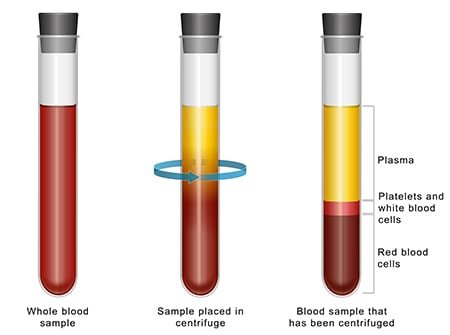
Platelet-Rich Plasma
Platelet-Rich Plasma
There are a number of small cellular components located in the blood supply that circulate throughout the body. However, these components, namely the red blood cells, white blood cells, and platelets, account for only a fraction of the blood supply as the majority is a liquid composition called plasma. Platelets are fragments of large bone marrow cells that contain numerous growth factor proteins that are responsible for repairing injuries and, together with coagulation factors, play an important role in blood clot initiation.
The liquid portion of blood containing an increased concentration of platelets and growth factors is known as platelet-rich plasma (PRP). This concentration of platelets and growth factors can be 5-10 times greater than the concentration naturally found in the blood supply. This natural biologic treatment is designed to reduce pain and inflammation, rebuild cartilage, and repair ligaments. Current research on platelet-rich plasma has shown this treatment to be a promising cost-effective alternative to surgery for many orthopaedic conditions.
How PRP is Prepared
Preparation of the platelet-rich plasma begins by drawing blood from the patient. Due to the varying densities of the different blood components, the blood sample is placed into a centrifuge that spins rapidly to separate out the platelets from the remainder of the blood. This concentration of platelets is then added back into the plasma and injected directly into the injury site.
PRP Efficacy
Although the future of platelet-rich plasma therapy is encouraging as a cost-effective treatment alternative for sports injuries, laboratory studies are still being conducted to evaluate the effectiveness of this biologic treatment. Platelet-rich plasma has been shown to improve the outcomes of certain tendon conditions in addition to a significant amount of literature documenting the considerable reduction in mild to moderate knee osteoarthritis symptoms. Though this cost-effective treatment alternative may not be successful for everyone, the following are factors that can determine the efficacy of platelet-rich plasma therapy:
The patient’s overall health (i.e., age, activity level, and medical history)
Acute injury vs chronic injury
The injury site location
The cellular composition of the platelet-rich plasma preparation
Conditions Treated with PRP
Patients are good candidates for this platelet-rich plasma when other conservative treatment measures have been unsuccessful. Platelet-rich plasma therapy has been shown to be beneficial for knee pain in mild to moderate osteoarthritis. Some of the other conditions currently undergoing study of platelet-rich plasma effectiveness are as follows:
Osteoarthritis
Chronic tendon injuries
Muscle strains and sprains
Pain and instability in various joints
Joint injuries, specifically the shoulder, elbow, knee, and ankle
For more information on platelet-rich plasma biologic treatment, please contact our office for a consultation.
How PRP Works
When a break in a blood vessel wall occurs, platelets react by clumping together to form a plug. This blood clot initiation, known as primary hemostasis, launches a cascade of actions from coagulation factors to revascularize the injury site and construct new tissue. Although the exact mechanism of how platelet-rich plasma operates is not entirely known, research has shown platelet-rich plasma can accelerate the healing process by activating inherent immune system processes as well as providing the necessary components for building new tissue.
Orthopedic Surgeon and Sports Medicine specialist, Dr. Jonathan Koscso, successfully diagnoses and treats patients in Sarasota, FL and the surrounding Gulf Coast region who have experienced an injury that can be treated with platelet-rich plasma.
About the Author
Dr. Jonathan Koscso is an orthopedic surgeon and sports medicine specialist at Kennedy-White Orthopaedic Center in Sarasota, FL. Dr. Koscso treats a vast spectrum of sports conditions, including shoulder, elbow, knee, and ankle disorders. Dr. Koscso was educated at the University of South Florida and the USF Morsani College of Medicine, followed by orthopedic surgery residency at Washington University in St. Louis/Barnes-Jewish Hospital and sports medicine & shoulder surgery fellowship at the Hospital for Special Surgery in New York City, the consistent #1 orthopaedic hospital as ranked by U.S. News & World Report. He has been a team physician for the New York Mets, Iona College Athletics, and NYC’s PSAL.
Disclaimer: All materials presented on this website are the opinions of Dr. Jonathan Koscso and any guest writers, and should not be construed as medical advice. Each patient’s specific condition is different, and a comprehensive medical assessment requires a full medical history, physical exam, and review of diagnostic imaging. If you would like to seek the opinion of Dr. Jonathan Koscso for your specific case, we recommend contacting our office to make an appointment.



